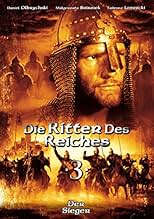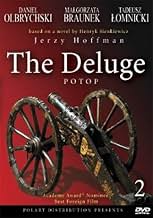CALIFICACIÓN DE IMDb
7.7/10
3.3 k
TU CALIFICACIÓN
Agrega una trama en tu idiomaDuring the 1655 war between Protestant Sweden and Catholic Polish-Lithuanian Commonwealth some Polish-Lithuanian nobles side with Swedish king Charles X Gustav while others side with the Pol... Leer todoDuring the 1655 war between Protestant Sweden and Catholic Polish-Lithuanian Commonwealth some Polish-Lithuanian nobles side with Swedish king Charles X Gustav while others side with the Polish king Jan Kazimierz.During the 1655 war between Protestant Sweden and Catholic Polish-Lithuanian Commonwealth some Polish-Lithuanian nobles side with Swedish king Charles X Gustav while others side with the Polish king Jan Kazimierz.
- Nominado a 1 premio Óscar
- 4 premios ganados y 1 nominación en total
Argumento
¿Sabías que…?
- TriviaThe third most popular film in the history of Polish cinema, with more than 27.6 million tickets sold in its native country by 1987, and 30.5 million sold in the Soviet Union.
- ConexionesFeatured in Sexify: Episode #1.6 (2021)
Opinión destacada
What sets Potop ('The Deluge') apart from the majority of international films is that it manages to escape the art-house ghetto that so many are resigned to, and stand on its own as an engaging piece of storytelling with memorably-drawn characters.
Director Jerzy Hoffman had nearly all of this handed to him on a silver platter. Based on the massive second volume of Henryk Sienkiewicz's Polish Trilogy, Potop follows the crimes, tribulations, and redemption of the nobleman Andrei Kmicic, set against the backdrop of the Swedish Invasion of the Polish-Lithuanian Commonwealth. As a historical epic it is unparalleled, akin more to the works of Tolkien than Dumas, and this all comes down to the strength of the narrative, setting, events, and characterizations, all of which are suitably larger-than-life. Sienkiewicz himself would never really top his work here, and it's no surprise that Hoffman's adaption of the third book in the Trilogy (Pan Wolodyjowski, filmed first though it was the third book) did and does not register much. (It's the weakest book of the three by far).
Though its four-hour runtime will probably repel most American viewers, Potop does contain at least one showstopper sequence that earns its place in film history and cult-movie fandom: this is the sword-fight between the desperate Kmicic and the knight Pan Wolodyjowski. The scene only lasts around 5 minutes, but is such a carefully choreographed, Kurosawan wonder (the actors are visibly using real swords) that it is rightfully considered one of film's all-time greatest sword fights. Throughout the film Hoffman shows a keen aptitude for shooting carnage, but possibly at the expense of everything else; he seems to have little interest in cinematic blocking, and the most effective scene from the book (Radziwill's abrupt betrayal) is rendered strangely flat and unaffecting. With a production this massive, however, perhaps expectations should be a bit tempered.
Potop is a curious contrast to another immensely popular Polish blockbuster, 'Krzyzacy' (Knights of the Teutonic Order, also based on a book by Sienkiewicz), and filmed 14 years earlier in 1960. Krzyzacy was a gorgeously made film with cinematography about on par with Hollywood, but was populated by shallow stock characters and driven by (as per the depiction in a the film) a somewhat vapid youthful romance. The romantic angle in Potop is far superior, with the central relationship between Kmicic and Olenka far more developed and emotionally-wrought than that of Krzyzacy. That being said, the cinematography is uglier and the set-pieces simpler in Potop; maybe because of the extended runtime the budget seems somewhat reduced, the filmmaking less professional. The two films are an interesting microcosm of classic filmmaking versus 70s filmmaking; despite the latter's immovable grasp on the hearts of movie fans, it marked a decided decline in the technical professionalism seen during previous decades. Ultimately, however, Potop remains the better film due to its thematic breadth and narrative complexity.
Director Jerzy Hoffman had nearly all of this handed to him on a silver platter. Based on the massive second volume of Henryk Sienkiewicz's Polish Trilogy, Potop follows the crimes, tribulations, and redemption of the nobleman Andrei Kmicic, set against the backdrop of the Swedish Invasion of the Polish-Lithuanian Commonwealth. As a historical epic it is unparalleled, akin more to the works of Tolkien than Dumas, and this all comes down to the strength of the narrative, setting, events, and characterizations, all of which are suitably larger-than-life. Sienkiewicz himself would never really top his work here, and it's no surprise that Hoffman's adaption of the third book in the Trilogy (Pan Wolodyjowski, filmed first though it was the third book) did and does not register much. (It's the weakest book of the three by far).
Though its four-hour runtime will probably repel most American viewers, Potop does contain at least one showstopper sequence that earns its place in film history and cult-movie fandom: this is the sword-fight between the desperate Kmicic and the knight Pan Wolodyjowski. The scene only lasts around 5 minutes, but is such a carefully choreographed, Kurosawan wonder (the actors are visibly using real swords) that it is rightfully considered one of film's all-time greatest sword fights. Throughout the film Hoffman shows a keen aptitude for shooting carnage, but possibly at the expense of everything else; he seems to have little interest in cinematic blocking, and the most effective scene from the book (Radziwill's abrupt betrayal) is rendered strangely flat and unaffecting. With a production this massive, however, perhaps expectations should be a bit tempered.
Potop is a curious contrast to another immensely popular Polish blockbuster, 'Krzyzacy' (Knights of the Teutonic Order, also based on a book by Sienkiewicz), and filmed 14 years earlier in 1960. Krzyzacy was a gorgeously made film with cinematography about on par with Hollywood, but was populated by shallow stock characters and driven by (as per the depiction in a the film) a somewhat vapid youthful romance. The romantic angle in Potop is far superior, with the central relationship between Kmicic and Olenka far more developed and emotionally-wrought than that of Krzyzacy. That being said, the cinematography is uglier and the set-pieces simpler in Potop; maybe because of the extended runtime the budget seems somewhat reduced, the filmmaking less professional. The two films are an interesting microcosm of classic filmmaking versus 70s filmmaking; despite the latter's immovable grasp on the hearts of movie fans, it marked a decided decline in the technical professionalism seen during previous decades. Ultimately, however, Potop remains the better film due to its thematic breadth and narrative complexity.
- DrTuvok
- 13 dic 2022
- Enlace permanente
Selecciones populares
Inicia sesión para calificar y agrega a la lista de videos para obtener recomendaciones personalizadas
- How long is The Deluge?Con tecnología de Alexa
Detalles
- Fecha de lanzamiento
- Países de origen
- Idioma
- También se conoce como
- The Deluge
- Locaciones de filmación
- Pidhirtsi, Lviv Oblast, Ucrania(battle scenes)
- Productoras
- Ver más créditos de la compañía en IMDbPro
Taquilla
- Presupuesto
- PLN 100,000,000 (estimado)
Contribuir a esta página
Sugiere una edición o agrega el contenido que falta

Principales brechas de datos
What is the Spanish language plot outline for El diluvio (1974)?
Responda


































